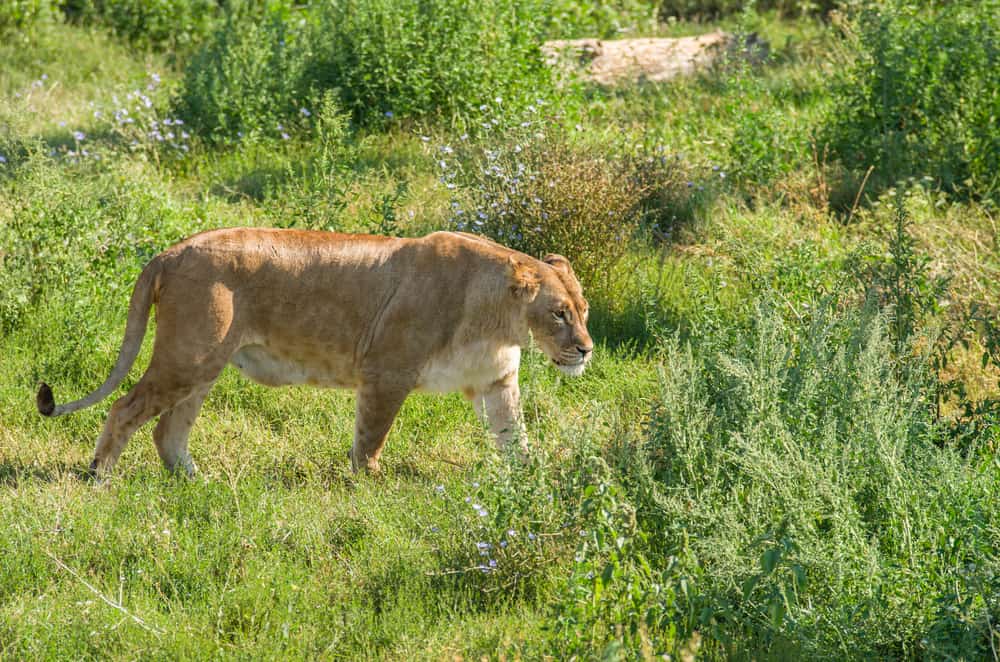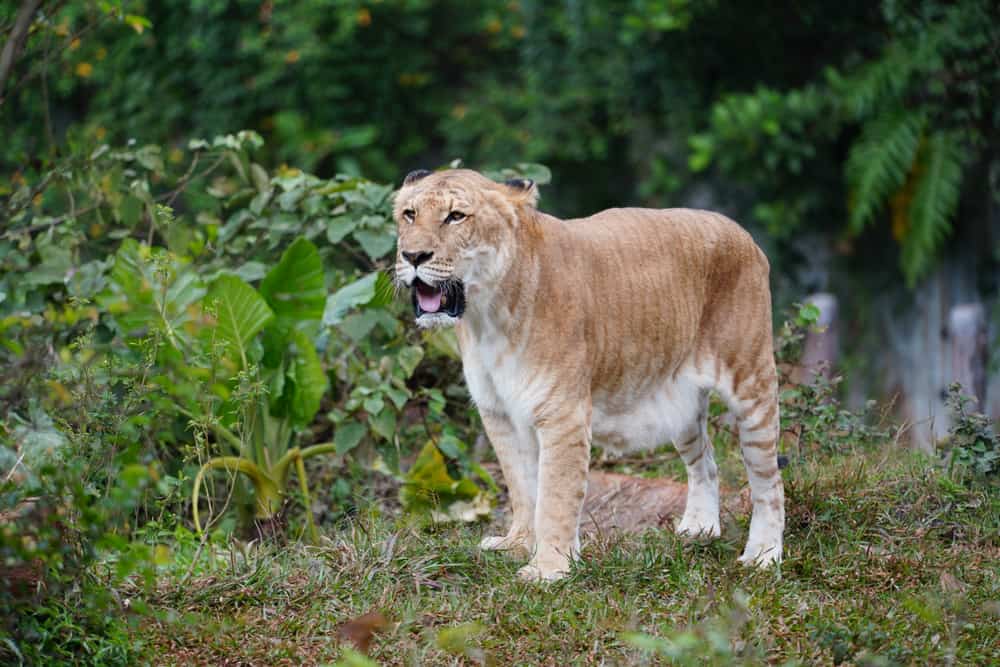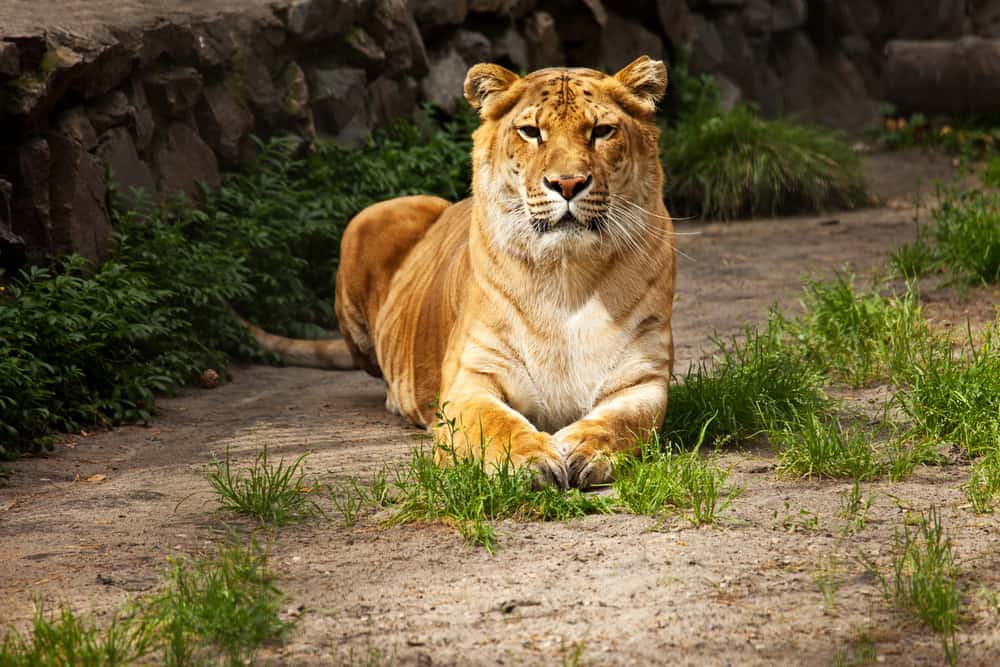Have you ever heard that saying, ‘curiosity killed the cat?’
Well, humanity’s meddling with what only the Creator is capable of has reduced natural selection and adaptation to an unfortunate manipulation of the big cat species.
So, what do you call a lion with stripes?
If you guessed a liger, then you are right. Ligers are a zoo-bred species that immediately succumb to genetic risk. In addition, this hybrid cat cannot survive in the wild as it does not have a place with either of its parent species.
Liger Habits and Biology
The liger, a hybrid cat of gigantic proportion, is the topic for debate amongst governments and conservationists worldwide. Again, it is the product of cross-breeding a male lion with a female tigress in captivity.
Other than the Gir National Forest in India, lion, and tiger ranges typically do not overlap. In the wild, the lion thrives in the African savannah, whereas the tiger makes its home in Asia’s denser, forested habitats.
Both of these majestic animals are apex predators, meaning that they are the hunters-never the hunted. In addition, lions and tigers are both endowed with aesthetically beautiful and exceptionally strong physical features.
Lions, often called the ‘King of the Jungle,’ are typically much lazier than the more aggressive tiger. In addition, lions are more social than tigers, who prefer a much more solitary lifestyle.
The liger, a designer hybrid between lion and tiger, exhibits many traits from its parents; however, ligers are usually bigger and heavier. Known to grow to almost twelve feet in length, a non-obese liger can weigh up to 900 pounds.
A liger’s skin resembles the tawny color of its father lion and embellishes a fainter hue of stripes to match its mother tigress. But, unfortunately, a liger’s beauty marks do not cover the internal scarring left by this genetic mashup.
PETA notates that ligers are prone to debilitating medical diagnoses, including “neurological defects, sterility, cancer, arthritis, organ failure, and diminished life expectancy.”
Studies further indicate that ligers lack a growth-limiting gene from their mother tigress, perpetuating its growth dysplasia syndrome. In laymen’s terms, a more straightforward explanation is that a liger’s genetic mutation causes the feline to remain in puberty.
Ligers have a broad head, powerful jaw, sharp claws, and very muscular bodies. Nonetheless, these feline creatures appear socially awkward as they can roar like a lion yet enjoy a cool splash in the water like a tiger.
Of the 100 ligers that exist today, the United States is home to the largest population (about 30) globally, with China right behind them (with about 20). The remaining population resides amongst various zoos and wildlife sanctuaries in Germany, South Korea, South Africa, and Russia.
Unfortunately, the hybrid breeding of lions and tigers provides no known genetic or scientific advantage to its parent species, which, as you should know, are currently listed as vulnerable and endangered, respectfully by the International Union for the Conservation of Nature (IUCN) as of 2021.
What Do Ligers Eat in the Wild
The 2004 “Napolean Dynamite” movie release sparked public curiosity about a mythical creature bred for its magic skills. I cannot even begin to express how ridiculous that sounds.
Nonetheless, greed and selfish gain will always provide a means, even if it eventually leads to an end. And many spectators seem to believe that the more recent explosion in liger breeding is the unfortunate result.
Ligers are non-existent in the wild, so therefore this section’s title is quite misleading. What we will instead look at are the dietary needs of this “Hollywood hybrid.”
Typically, animals do not become consistently overweight; instead, they may experience some weight gain or loss in the wild based on seasonal cycles and food availability.
Captive animals not only live in enclosures but are unable to exercise their natural hunting instincts. As a result, animals in captivity exert much less physical energy than what would otherwise be necessary for their survival in the wild.
If we take a second look at size for a minute, it is interesting to note the correlation between size and hunting ability in the wild. For example, a male lion possesses a growth gene because, for this cat, its larger size equals dominance. However, its female mate neutralizes this gene because it believes that bigger is not always better. On the other hand, tigresses do not carry a gene that limits the size of their cubs.
When a lion meets a tiger, its offspring can be larger than both parents combined. The world’s largest known liger named Hercules weighs in at 922 pounds and measures 49 inches in height; he still holds the current record in the Guinness World Records.
Ligers require an outrageous amount of nutrition due to their size and growth. This gigantic carnivore can consume up to one hundred pounds of meat in one sitting, although reports indicate that its average meal may consist of twenty-five to fifty pounds of raw meat alone.
In the case of the liger, its extreme appetite paired with an unusually sedentary lifestyle is a combination ripened for obesity. The associated risks of its obesity include extra stress placed on this big cats’ organs.
More Facts About Ligers
There may be more than 2 billion species of plants, animals, fungi, and bacteria in existence today. So, what is causing population loss in lions and tigers?
Research hints that the breeding of ligers is man’s way of ensuring that neither big cat species dies out completely. However, we need to understand what causes an animal species to become extinct.
According to National Geographic, an animal species “dies out from cataclysmic events, evolutionary problems, or human interference.”
Unfortunately, you will find that illegal poaching and unsustainable trophy hunting are probably the two leading causes of population depletion in the Panthera Leo species. In addition, lions also suffer from habitat loss, fragmentation, and conflict with people over livestock depredation.
The plight of the tiger population (Panthera Tigris) again suffers at the hand of human contact. Besides fragmentation of their habitat, tigers are illegally hunted, killed, and traded in the black market for rugs and coats, bones, and other body parts (for so-called medicinal purposes).
These fascinating cats have not been affected by either cataclysmic events or evolutionary problems- instead, their affliction stems from the touch of the human hand.
With this knowledge, what advantages could there possibly be for creating a hybrid cat? In my opinion, entities such as the Myrtle Beach Safari, founded by celebrity Doc Antle, are completely unethical in their train of thought and have no right to breed ligers.
The first liger births date back to 18th century India, with the subsequent most notable breeding occurring in the early 1900s. However, the last couple of decades have been the most active for liger breeding in history.
Countries like Taiwan have entirely outlawed breeding two protected species, including the Panthera Leo and Panthera Tigris species.
Other countries follow Taiwan’s Conservation Program, but unfortunately, this breeding continues in several countries via legislative loopholes.
Ligers do not measure up to the criterion of being a species of their own. Due to its mutated genetic build, ligers have a shortened lifespan and demonstrate infertility issues while females frequently birth sickly cubs.
Unfortunately, liger cubs often acquire congenital disabilities, which lead to the early demise of many. In addition, female tigress’ undergo assisted births (c-section) due to the significantly larger size of their inbred cub. In most cases, the female sadly dies.
Public amusement far too often dislodges ethics from society’s hands. If these cats must live captive lives without ever having the opportunity to live outside their enclosures, what other interest is there in these larger-than-life beasts?
It is impossible to refrain from talking about ethics when informing new readers about ligers. These cats were never supposed to exist, yet many even have these gigantic beasts as pets now.
The result of cross-breeding lions and tigers to produce a big cat whose survival depends on its captivity is an “evolutionary dead-end.”
The Crown Ridge Tiger Sanctuary argues that breeders are “creating potentially unhealthy, unstable animals while ignoring the plight of those already endangered; it is unfair to both the hybrid offspring and its parent species, and there is nothing magical about it.”
Summary
I believe that it is now our responsibility to advocate for the care and well-being of the ligers that are in existence today. It is incumbent upon us not to support breeders who wish to exploit these giant beasts.
Instead, we can raise awareness and support authentic conservation programs that aim to end the illegal hunting and trading of the magnificent Panthera Leo and Tigris species.
In my opinion, Planet Earth can accommodate all of its various life forms and subspecies. We can choose to cohabitate with the animal kingdom and observe and appreciate their existence without trampling on their space.
Please comment below with any ideas or questions you may have about protecting big cats and ensuring that hybrid breeding no longer continues.


